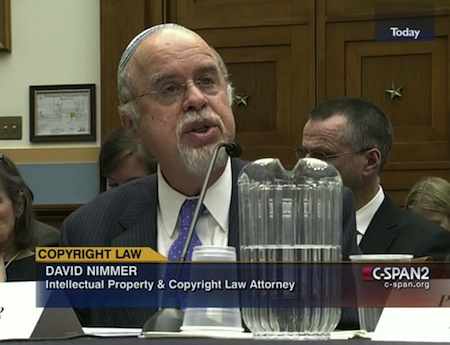Nimmer on Aereo: It's Illegal

A pair of leading copyright law professors with scores of papers and books under their belts have told the Supreme Court that Aereo's service is illegal. They say that in denying broadcasters' request for an injunction against Aereo, the court got just about everything wrong, misconstruing the "text, structure, specific legislative guidance, and general legislative purposes of the 1976 [Copyright] Act."
That came in an amicus brief to the Supreme Court from Berkeley law professor Peter Menell and UCLA law professor David Nimmer, who along with his father wrote the book, literally, on copyright law, Nimmer on Copyright. (Nimmer has testified about copyright law in Congress on behalf of the National Association of Broadcasters).
In their brief, they say that the Second Circuit handed Aereo a copyright "get-out-of-jail-free card" that unravels the basis of the Copyright Act of 1976 that Congress has reaffirmed numerous times.
"That ruling cannot stand," they argue.
The key point is whether Aereo is providing a public performance of a copyrighted work without compensation, or providing the technology to access free TV signals over the Internet. The professors argue it is clearly the former. "We respectfully submit that the Court should hold that Aereo’s service infringes the copyright owners’ exclusive right of public performance," they said. "The one constant [in copyright law regarding TV transmissions] is that Congress has considered infringing any service that provides television signals on a wholesale basis."
Broadcasters March 4 were pointing particularly to the professors' discussion of Nimmer's father, Melville Nimmer's discussion of the transmit clause and public performance right, which was cited by the Second Circuit in support of its decision that Aereo was likely not illegal.
The Copyright Act's transmit clause holds that there is copyright liability “whether the members of the public capable of receiving the performance or display receive it in the same place or in separate places and at the same time or at different times.”
Broadcasting & Cable Newsletter
The smarter way to stay on top of broadcasting and cable industry. Sign up below
Melville Nimmer said it was difficult to believe that Congress had meant that "the performance of music on a commercial phonograph record in the privacy of one’s home constitutes a public performance because other members of the public will be playing duplicates of the same recorded performance 'at different times.' It is absurd to suppose that under the current Act it has become necessary for private purchasers of phonorecords to obtain a performing rights license."
Instead, Nimmer concluded that what Congress meant was that "if the same copy (or phonorecord) of a given work is repeatedly played (i.e., ‘performed’) by different members of the public, albeit at different times, this constitutes a ‘public’ performance."
It is that conclusion that the Second Circuit points out to support Aereo. But David Nimmer and Menell argue that the court misses the point that Aereo should be looked at as an unprecedented service that is the functional equivalent of a cable system, whose copyright liability for TV transmissions has been minutely regulated via the Copyright Act and various incarnations of the Satellite Home Viewer Act (now STELA). "Because such systems were technologically feasible neither at the time that the 1976 Act was passed nor when Professor Melville B. Nimmer analyzed the pertinent provisions, deeper statutory archaeology is required to determine the proper interpretation."
The Supreme Court is hearing broadcasters' appeal of the Second Circuit's refusal to grant an injunction against Aereo, which has continued to roll out its TV station-delivery service. Aereo and its supporters have yet to file their briefs. The Supreme Court is hearing oral argument April 22.
Contributing editor John Eggerton has been an editor and/or writer on media regulation, legislation and policy for over four decades, including covering the FCC, FTC, Congress, the major media trade associations, and the federal courts. In addition to Multichannel News and Broadcasting + Cable, his work has appeared in Radio World, TV Technology, TV Fax, This Week in Consumer Electronics, Variety and the Encyclopedia Britannica.

